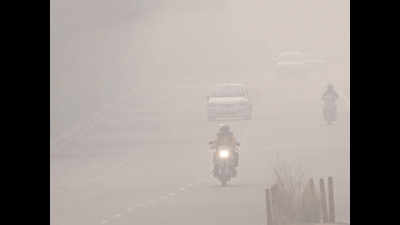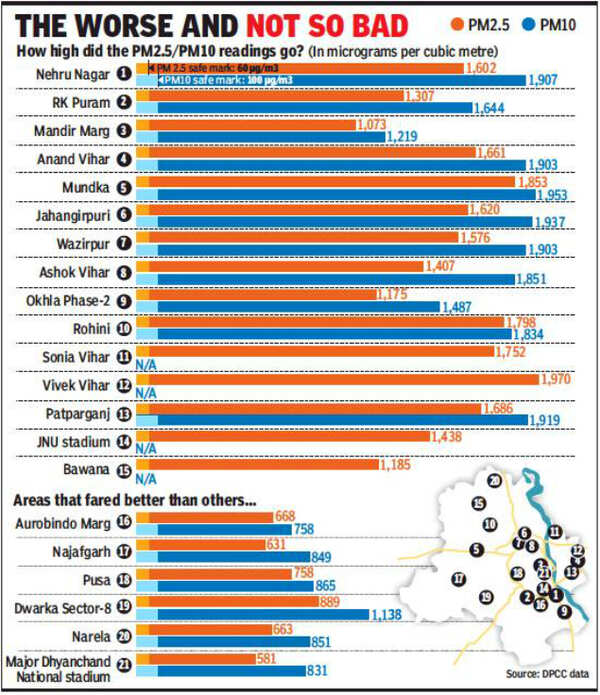- News
- City News
- delhi News
- Delhi: God help you if you stay at any of these locations
Trending
This story is from November 16, 2020
Delhi: God help you if you stay at any of these locations
With an hourly PM2.5 concentration of 1,970 micrograms per cubic metre (µg/m3) at 1am on Diwali night, pollution readings at east Delhi’s busy residential area Vivek Vihar touched 33 times the safe standard, the highest in the capital.

The peak pollution level across Delhi was generally recorded between midnight and 1am, but some locations saw a spike at 3am, including Mandir Marg
NEW DELHI: With an hourly PM2.5 concentration of 1,970 micrograms per cubic metre (µg/m3) at 1am on Diwali night, pollution readings at east Delhi’s busy residential area Vivek Vihar touched 33 times the safe standard, the highest in the capital. This was the result of the firecracker ban being flouted widely across Delhi-NCR on Saturday. The safe standard for PM2.5 is 60 µg/m3.
Track the pollution level in your city
Mundka in west Delhi followed close behind with the hourly PM2.5 concentration touching 1,853 µg/m3, while it was 1,798 µg/m3 in the bustling sub-city of Rohini in north Delhi, data from DPCC showed.

The peak pollution level across Delhi was generally recorded between midnight and 1am, but some locations saw a spike at 3am, including Mandir Marg. This indicated that firecrackers may have been burst there well past midnight. The hourly PM2.5 concentration in the area touched 1,073 µg/m3 at 3am, the highest through the day. Sonia Vihar (1,752 µg/m3) and Patparganj (1,686 µg/m3) were some other busy residential areas that recorded high PM2.5 levels close to midnight.
“A steep increase in PM2.5 indicates additional emissions being introduced to Delhi’s air, which was largely through firecrackers. While the base pollution in the morning was high, this increased manifold by the evening. Peak readings were recorded at midnight at most locations,” said a DPCC official.
Meanwhile, locations like Major Dhyan Chand National Stadium, which is not surrounded by a residential locality, recorded the lowest readings across Delhi with a PM2.5 concentration of 581 µg/m3. Similarly, Narela, an industrial area, recorded a PM2.5 peak of 663 µg/m3.
In 2019, Vivek Vihar (east Delhi), Ashok Vihar (northwest), Anand Vihar (east), Wazirpur (northwest) and Jahangirpuri (north) were the most polluted locations on Diwali day. The five cleanest stations last year were Najafgarh, Sri Aurobindo Marg, Alipur, Narela and Pooth Khurd (Bawana).
Data from CPCB, which monitored the three locations of ITO, Janakpuri and Pitampura on Diwali day, showed that almost all parameters, including SO2, NO2, PM2.5 and PM10, were higher this year compared with 2019. “Pitampura recorded a significant increase in PM and SO2, indicating a huge impact of firecrackers,” said CPCB.
The average PM2.5 level at Pitampura was 865 µg/m3 through the day compared with 511 µg/m3 last Diwali. At ITO, the average PM2.5 level was 454 µg/m3 compared with 291 µg/m3 last year, while at Janakpuri there was a minor spike to 535 µg/m3 from 513 µg/m3 in 2019.
Track the pollution level in your city
Mundka in west Delhi followed close behind with the hourly PM2.5 concentration touching 1,853 µg/m3, while it was 1,798 µg/m3 in the bustling sub-city of Rohini in north Delhi, data from DPCC showed.

In contrast, it seemed that the residential areas around Aurobindo Marg stuck to the cracker ban, with hourly readings touching a high of just 668 µg/m3. Similar low readings were recorded at Najafgarh (631 µg/m3), Dwarka Sector 8 (889 µg/m3) and Pusa (758 µg/m3), indicating some compliance with the ban. All pollution reading stations recorded PM2.5 over 10 times the safe standard on Diwali day, DPCC data showed.
The peak pollution level across Delhi was generally recorded between midnight and 1am, but some locations saw a spike at 3am, including Mandir Marg. This indicated that firecrackers may have been burst there well past midnight. The hourly PM2.5 concentration in the area touched 1,073 µg/m3 at 3am, the highest through the day. Sonia Vihar (1,752 µg/m3) and Patparganj (1,686 µg/m3) were some other busy residential areas that recorded high PM2.5 levels close to midnight.
“A steep increase in PM2.5 indicates additional emissions being introduced to Delhi’s air, which was largely through firecrackers. While the base pollution in the morning was high, this increased manifold by the evening. Peak readings were recorded at midnight at most locations,” said a DPCC official.
Meanwhile, locations like Major Dhyan Chand National Stadium, which is not surrounded by a residential locality, recorded the lowest readings across Delhi with a PM2.5 concentration of 581 µg/m3. Similarly, Narela, an industrial area, recorded a PM2.5 peak of 663 µg/m3.
In 2019, Vivek Vihar (east Delhi), Ashok Vihar (northwest), Anand Vihar (east), Wazirpur (northwest) and Jahangirpuri (north) were the most polluted locations on Diwali day. The five cleanest stations last year were Najafgarh, Sri Aurobindo Marg, Alipur, Narela and Pooth Khurd (Bawana).
Data from CPCB, which monitored the three locations of ITO, Janakpuri and Pitampura on Diwali day, showed that almost all parameters, including SO2, NO2, PM2.5 and PM10, were higher this year compared with 2019. “Pitampura recorded a significant increase in PM and SO2, indicating a huge impact of firecrackers,” said CPCB.
The average PM2.5 level at Pitampura was 865 µg/m3 through the day compared with 511 µg/m3 last Diwali. At ITO, the average PM2.5 level was 454 µg/m3 compared with 291 µg/m3 last year, while at Janakpuri there was a minor spike to 535 µg/m3 from 513 µg/m3 in 2019.
End of Article
FOLLOW US ON SOCIAL MEDIA










